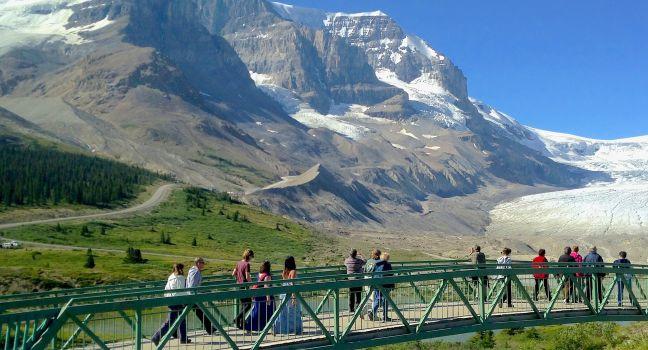With picturesque views of flowing waterfalls, mountains, and glaciers, the Berg Lake Trail has become a legendary backpacking destination. This moderately difficult 21-km (13-mile) one-way hike is one of the most popular overnight trails in the Canadian Rockies. Turquoise-blue Berg Lake gets its name from the fact that it's dotted with mini icebergs---even in the middle of summer. The lake sits at the base of the north face of Mount Robson and glaciers on the mountain regularly calve off into the water.
This well-maintained trail takes hikers to some of the best scenery in the Canadian Rockies. The first 4.5 km (2.8 miles) are relatively easy hiking along the Robson River and then through dense forest before arriving at glacier-fed Kinney Lake. After crossing a steel bridge at the end of Kinney Lake, it's just 2.8 km (1.7 miles) to the Kinney Lake campground.
Beyond the Kinney Lake campground, the trail splits and gives the option of hiking through Kinney Lake Flats or continuing through the forest. At that point, the trail merges together again and begins climbing steeply to the Valley of a Thousand Falls where it provides views of four spectacular waterfalls. The trail then crosses the Robson River on a suspension bridge and arrives at Whitehorn campground at the 11-km (6.8-mile) mark.
Once the trail gets above the valley, you will start getting glimpses of the Emperor Face of Mount Robson. The Emperor Campground lies about 3 km (1.9 miles) from the shores of Berg Lake. Marmot Campground and Berg Lake Campground sit right on the shores of the lake. Several popular day hikes depart from the Berg Lake Campground and there are two more campgrounds just past the lake, Rearguard and Robson Pass.
The Berg Lake Trail is one of the most popular backpacking trails in the Canadian Rockies and campsites should be booked well in advance, especially during the peak summer months. All hikers must check in at the Mount Robson Visitor Centre before setting out on the trail. In 2021, the portion of the trail past Kinney Lake was closed due to flood damage.
If you can't get a backcountry camping reservation on the Berg Lake Trail, you could opt to fly into Berg Lake and hike down the trail as a day hike. It would be very difficult to hike the trail in both directions in a single day. Difficult.




